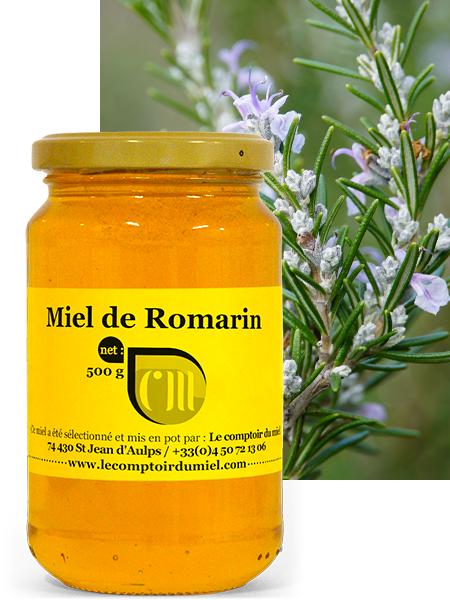Our beekeeper, based in the Moncayo Regional Nature Park in Aragon, supplies us with his first harvest of the year whenever he can.
It will be a welcome replacement for the harvest produced in the Corbières, which is always late in coming.
In France, it flourishes mainly in the Pyrénées Orientales department. Pyrénées Orientales. Narbonne rosemary is reputed to be the best! It used to be called “Narbonne honey”. Depending on the year, rosemary honey is more abundant on the southern side of the Pyrenees, where the winter heat is milder. And, above all, more conducive to abundant harvests.
Rosemary is an evergreen shrub. Its leaves are needle-thin with round edges. Its pale blue flowers appear at the end of winter and after frosts. It grows wild around the Mediterranean, but adapts well to other climates. It can withstand sub-zero temperatures, but not too low.
In dry weather, even the slightest dew can cause rosemary to flower. Harvesting, however, does not take place until May.
Rosemary honey in the kitchen:
Rosemary honey can be used in a variety of ways: For example, as a sweetener in teas or coffees. Add to cooking recipesspread on bread, or as an ingredient in vinaigrettes. vinaigrettes and sauces. With its unique, light, barely flavored taste, rosemary honey is the perfect sweetener for our evening herbal teas. It can also be added to fruit salads, pies or desserts. It can also be enjoyed on its own to appreciate its distinctive flavor and potential health benefits.
The color, smell and flavor of Aragon rosemary honey:
Clear in color, rather like acacia honey acacia honeyIt has a slightly aniseed flavor. Its scent is sweet and pleasant. It has a fine crystallization and can be kept for a long time. Its odor is faint, of medium intensity.
Properties of rosemary honey :
Rosemary is reputed to be a cholagogue. In other words, it has a beneficial effect on bile. In fact, it has been used for centuries in traditional medicine for its antimicrobial properties and its positive effects on digestion and memory!
Did you know?
During plague epidemics, rosemary was very popular: twigs were burned to purify the air, and people carried sachets with them to breathe in when passing through areas affected by this terrible disease.
History also has it that the Queen of Hungary, who suffered from chronic rheumatism, was cured of her problems by a rosemary-based remedy when she was 72.


Reviews
There are no reviews yet.